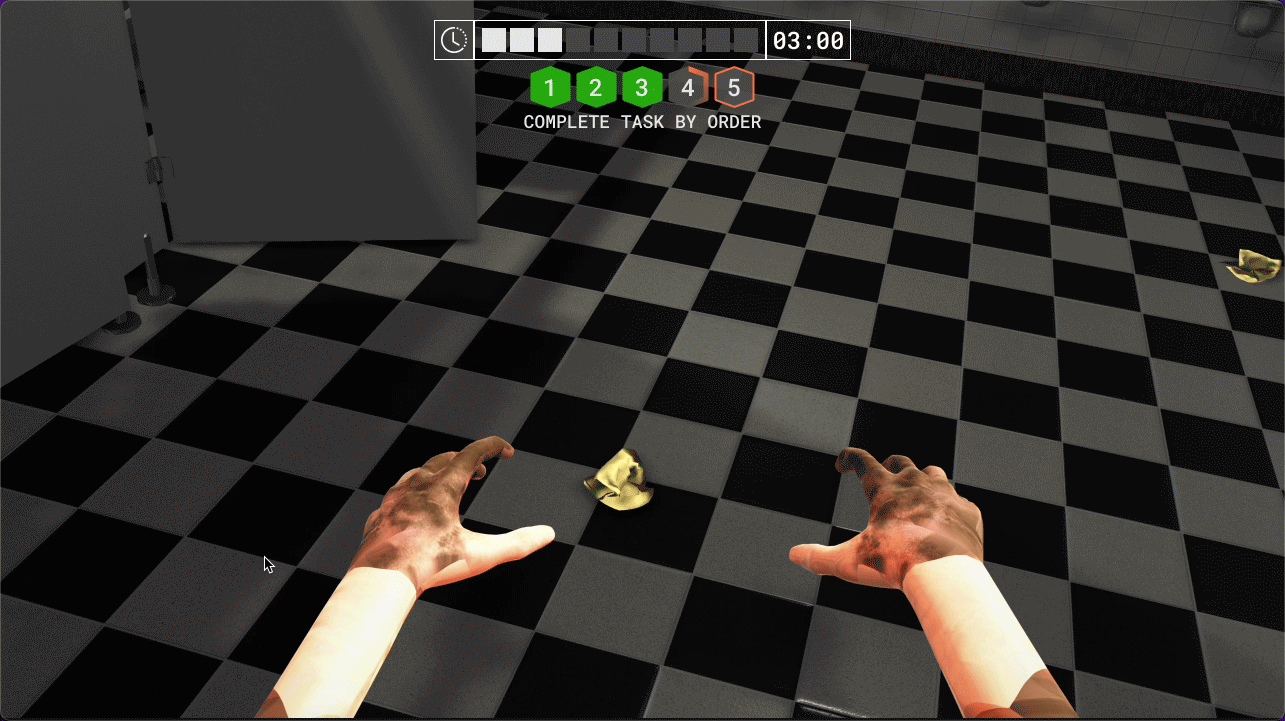
Mysophobia VR Game
Personal HCI Project
Jul-Oct, 2022




OVERVIEW
As a Mysophobia patient, I have found that Mysophobia has brought uncontrollable negative effects to me in situations that I am not aware of. For example, feeling anxious, inexplicable stress, and inconveniences in my daily life. Most of the patients are not willing to spend time, money, and energy on treatment because they think it is a trivial illness. Thus, I want to find a more accessible solution to treat and solve Mysophobia problems.
Mysophobia patients have symptoms like shaking, chronic pain, anxiety, crying, and rapid heartbeats, which physically or mentally impact their lives in negative ways. Through my secondary research, I discovered that treatments had the potential to raise patients’ anxiety due to high cognitive loads and mental pressure, leading to high treatment dropout rates. Over 16 weeks, I designed a game to relieve and treat Mysophobia. Leveraging Virtual Reality technology and implementing exposure therapy with the game, I provided an accessible and entertaining treatment experience for Mysophobia patients. Help Mysophobia patients get rid of the pain at a low mental pressure & low cost while having fun with the game.
Project --- Personal Project
Scope --- Product Thinking, Interaction Design, Gaming Design
Platform --- VR Game
Tool --- Figma, Unity, VR Headset, Visual Studio, Procreate, Google doc
DEFINITION OF MYSOPHOBIA
Mysophobia, also known as verminophobia, germophobia, germaphobia, bacillophobia and bacteriophobia, is a type of phobia that centers on an extreme and irrational fear of germs, dirt, or contamination.

SIGNS & SYMPTOMS
Behaviors

Washing your hands often, several times in a row, or for an unusually long time.

Returning home immediately if you fear you’ve been exposed to germs.

Avoiding social situations, even when they include loved ones.

Absenteeism at work.

Inability to perform certain daily tasks

Mood swings, depression and suicidal thoughts
Physical symptoms

Anxiety and secondary panic attacks

Shaking

Chronic pain (abdominal, headache)

Sweating

Rapid heartbeat
(palpitations)

Frequent bouts of crying
WHY Do People Have MYSOPHOBIA?

Family Education
Unscientific education: for example, parents strictly ask children to wash their hands often.

Environment
Emotional trauma related to germs or uncleanliness can cause mysophobia. It could stem from a loved one who got sick or died from a contaminated environment.

Genetics
A family history of anxiety disorders increases the likelihood of phobias.
HOW is Mysophobia DIAGNOSED?
In order to receive a diagnosis, there must be evidence that the fear of germs has interfered significantly with the individual’s daily life and relationships. Healthcare providers typically diagnose mysophobia in a single office visit. Testing isn’t necessary. Instead, healthcare providers ask patients about their symptoms and changes in their behaviors. Through a simple questionnaire, healthcare providers could diagnose the level of mysophobia in patients.

Questions may include:
-
How often do you think about germs?
-
Have you experienced a traumatic event related to germs?
-
How do germs make you feel?
-
Is mysophobia is causing behavioral changes that affect your happiness or daily routine?
-
Do you have a personal or family history of anxiety or obsessive-compulsive disorder?
-
Are you avoiding people or places you used to enjoy due to fear of germs?
4 levels of Mysophobia

CONCLUSION
Use the questionnaire as the way to diagnose the level of mysophobia, because:
Testing is unnecessary, diagnosis of mysophobia is based on patients’ symptoms
The diagnostic method is more rely on patients’ self-perception of the condition.

💭 REFLECTION 💭
Can patients complete the process of diagnosing mysophobia by themselves?
Why mysophobia patients are hesitant to go to health care?

What are the TREATMENTS?
Mysophobia is usually treated with therapy, medication, or a combination of the two. Drugs don’t cure mysophobia. But antidepressants can help with mood disorders, and anti-anxiety medications may help you cope in a stressful situation.
There are five types of therapy that treat mysophobia well:
Systematic Desensitization, Exposure Therapy, Flooding Therapy, Aversion Therapy, and Cognitive Behavior Therapy.
On a scale of 1-5, compare and contrast those therapies from 5 different aspects to evaluate the pros and cons among therapies :
-
Efficacy (E): the effectiveness of the treatment (helpless → helpful)
-
Duration (D): generally how long does the treatment take (long → short)
-
Implement (I): the difficulty of treatment implementation (hard → easy)
-
Cost (C): how much does the treatment cost (expensive → reasonable)
-
Mental Stress (M): level of mental stress forced on patients during treatment (high → low)

Opportunity gap = MENTAL PRESSURE + COST
Through my secondary research, I discovered that treatments had the potential to raise patients’ anxiety due to high cognitive loads and mental pressure, leading to high treatment dropout rates. Also, patients are not willing to spend time, energy, and money on treatment because they think it is a trivial illness. By comparing 5 different treatment methods, I discovered that the medical cost to take mysophobia therapy is expensive, which is one of the reasons why patients are hesitant to treat mysophobia.
By comparing 5 different types of treatment, I chose to use Exposure Therapy as the treatment. From the above graphs, we can see that exposure therapy is the most comprehensive treatment with both low mental pressure & cost.
Types of Exposure Therapy:
-
Real life: Being exposed to fear in real life
-
Imagined: vividly imagining a fear
-
Visual reality: Using virtual reality to be exposed to a fear
-
Interoceptive: Bringing sensations into play in an effort to disconfirm the idea that physical sensations will lead to harmful events

Final Decision
Choose Virtual Reality as the exposure method, because:
1. VR could provide immersive experiences, which visually expose patients to their fear without any guidance or instruction.
2. VR increases the accessibility of treatment for patients to complete the process of treatment by themselves whenever and wherever, such as at home, which reduces patients’ mental pressure while having a low cost for medical treatment → filling out the opportunity gap!
3 TYPES of Mysophobia

Behavioral
fear of germs, dirt, or contamination;
considering everything is dirty in extreme ways.

Mental
keep their spirit world absolute clean;
have an obsessive-compulsive personality in the spirit world;
set strict social rules for filtering people who to interact with.

Physical
fear of physical intimacy,
which can cause intense fear or panic when sexual intimacy is attempted.
USER RESEARCH
I have interviewed 10 participants who believe they have mysophobia. 10 participants were randomly selected from three different types of mysophobia. Through the interviews, I asked them to write down keywords of the objects that they have mysophobia concerns about.










After interviewing, I categorized those keywords according to 3 types of mysophobia by using circle graphs, which filtered out the highest-frequency objects in the interviews.




IDEA MINDMAP

MY IDEA =
Self-diagnosis + Exposure Therapy + VR + GAME
Implementing exposure therapy with the game form to make treatment accessible and interesting for Mysophobia patients.
Also, leveraging VR technology from the first-person perspective creates a more realistic experience for mysophobia patients.

Game Mechanics
The game is divided into 6 scenes, each scene corresponds to a different level. In each scene, the patient needs to control the character to complete the specified tasks within the specified time in order to advance to the next level. Each task will challenge the player's endurance to achieve the treatment effect.
The 6 scenes are Bedroom, Home, Restaurant, Elevator, Subway, and Restroom. I order the scenes based on users’ descriptions in user research and the difficulty of the tasks in each scenario.

Private & Clean
Public & Dirty
During the interviews, 9/10 of the patients reflected that beds and homes are places where they feel most comfortable, safe, and clean. The bed is where they find the most relaxation. According to the level of difficulty, I ranked the bedroom as the first level and the home as the second level.
7/10 of the patients reflected that the most unacceptable and uncomfortable place for them is the public restroom, so I ranked the public restroom as the last level.
SELF-DIAGNOSIS: Mysophobia Screening Test
First of all, users need to determine whether they have mysophobia problems.
I designed a mysophobia quiz prototype using Figma. It is a quick screening test that only takes about 5 minutes. It contains 10 mysophobia-related questions that can scientifically diagnose the user's level of mysophobia.
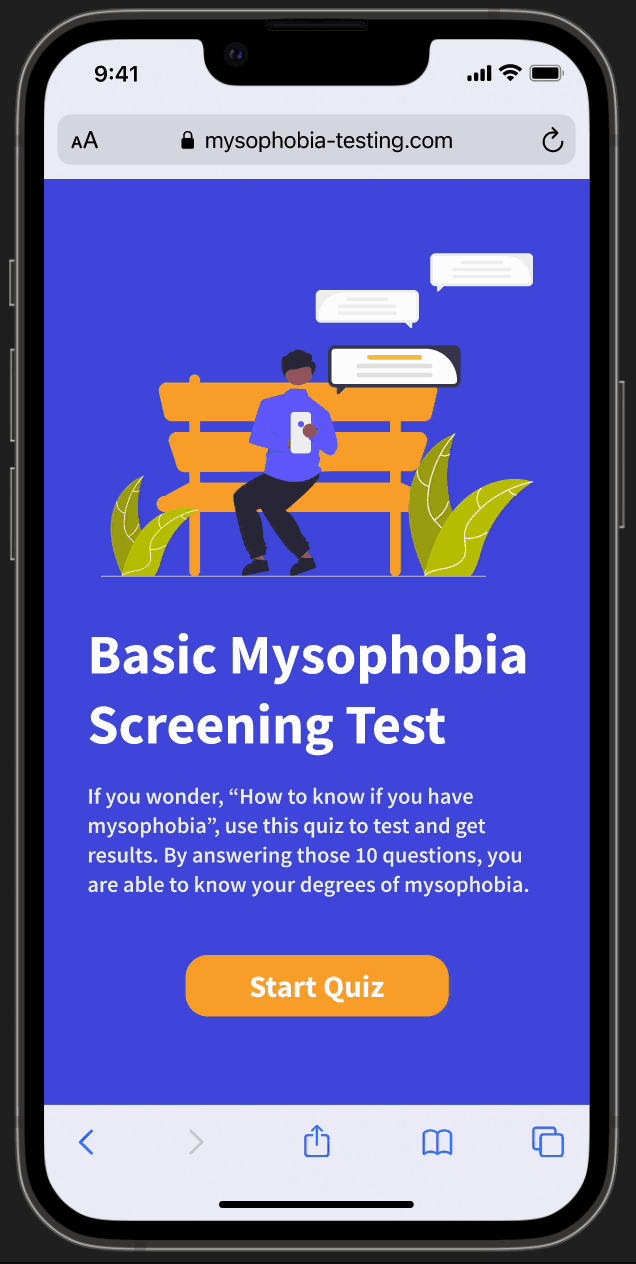
Start taking the quiz
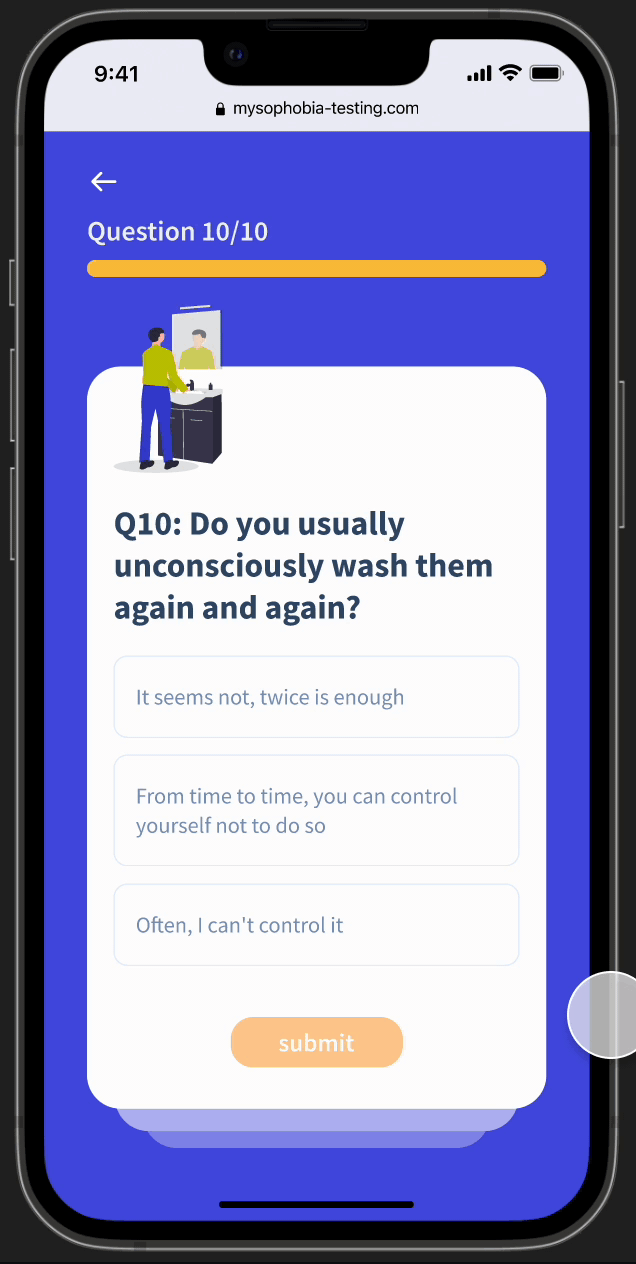
Finish the quiz and get the result
The results of the quiz correspond to the 4 levels of mysophobia.

According to the level of mysophobia, users could start the game from different levels.
If you are in level 1 “Low”, you do not need treatment.
If you are in level 2 “Moderate”, you can start from level 5 of the game.
If you are in level 3 “High”, you need to start from level 2 or 3 of the game.
If you are in level 4 “Extreme”, you need to start from level 1 or go see medical treatment.
The logic behind quiz result and game level:
The higher level of mysophobia severity, the lower the tolerance for the patients to accept challenges. Thus, severe patients need to start from the lower level of the game to confront the challenge step by step.
Designing Game PROTOTYPE #1: PUBLIC RESTROOM
Step 1: Constructing the public restroom
I used the game engine, unity, to build up the indoor scenes on the 3D platform for the game. The first place I constructed is the public restroom.
Dim light: create depressing environmental atmosphere
Dirty Objects: different objects represent different tasks of level 6. Applying different materials to objects creates a sense of being dirty, which raises players' sense of discomfort, adding difficulty to the tasks.

Public Restroom from other angles:




Step 2: Adding first-person controller
I decided to use the first-person's perspective VR because it allows the player to perceive the game through the eyes of the character, observing the environment around them up close, giving a clear view of the scenery in front of them, and more important providing the realistic experience for them and achieving therapeutic results.

1st person POV
In the first-person point of view, players could see their hands. As players upgrade to higher levels, their hands will go from clean to dirty. I applied contaminated material on the virtual hands to add a certain degree of psychological stress on players.

Clean hands = Level 1 & 2


Material settings



Level 3
Material settings

Level 4

Level 5

Dirty hands = Level 6
Step 3: Designing Tasks
I designed 5 tasks in the public restroom scenario:

TASK 1: Move the mop out of the way

TASK 3: Flushing the toilet by touching the button

TASK 2: Opening the door by touching handle

TASK 4: Picking up the dirty paper

TASK 5: Washing off the dirt on hands
Step 4: UI Design of the game
Introduction of the level 6....


Start the first tasks...

Timer
Task status
Task instruction
While doing the tasks...

Task progressing
Task instruction
After completed one task...

The task icon turned green after completed the task
Task completed
If the player hesitate to complete the task...

The timer and tasks would turn red to add pressure on player
The guidance would lead player to complete the task while release mental pressure
Closing of the level 6...

FINAL PRODUCT
Introduction
This is the beginning scene of level 6. The player would begin with a short introduction to level 6.
By nodding the head, the play is “clicking” the “next” button to continue. After a short introduction, the task begins…
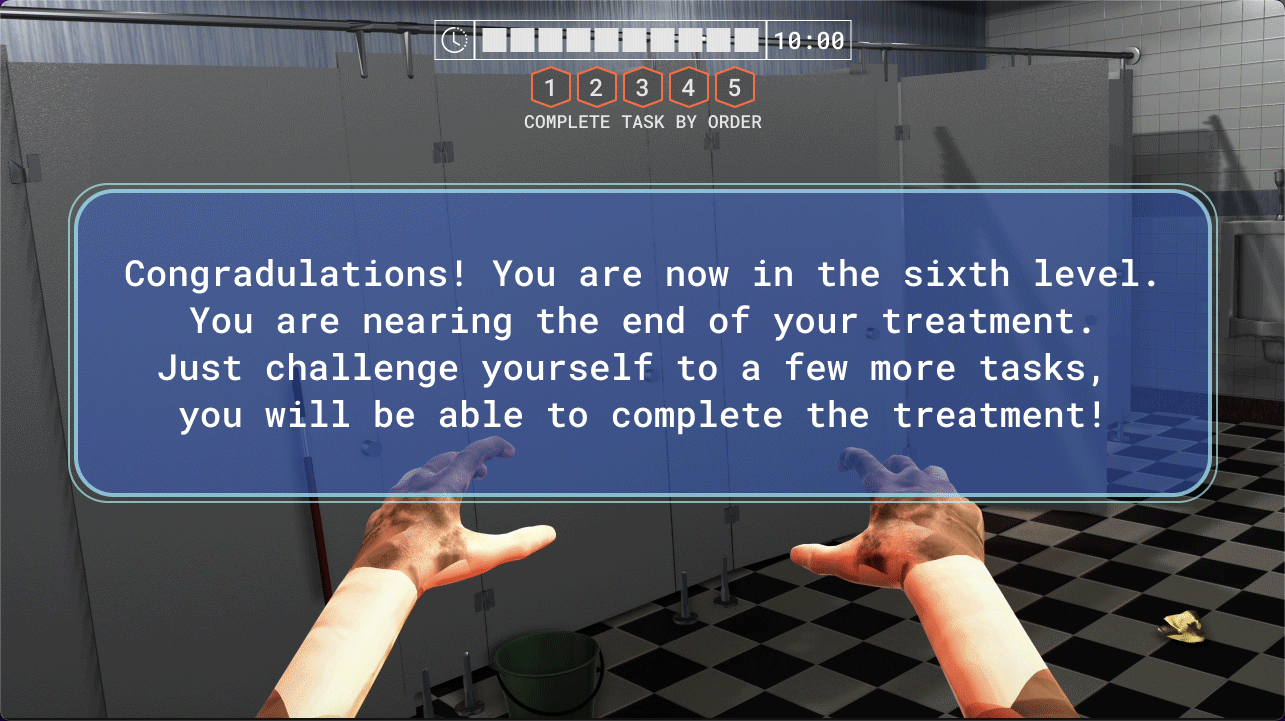
Tasks
This is an example of the player performing task 4: picking up the dirty paper. The player has to walk to designated locations and perform commands to complete the task. After the player completed it, the task icon on the top would turn in green, and the instruction on the right-down corner would also turn green.
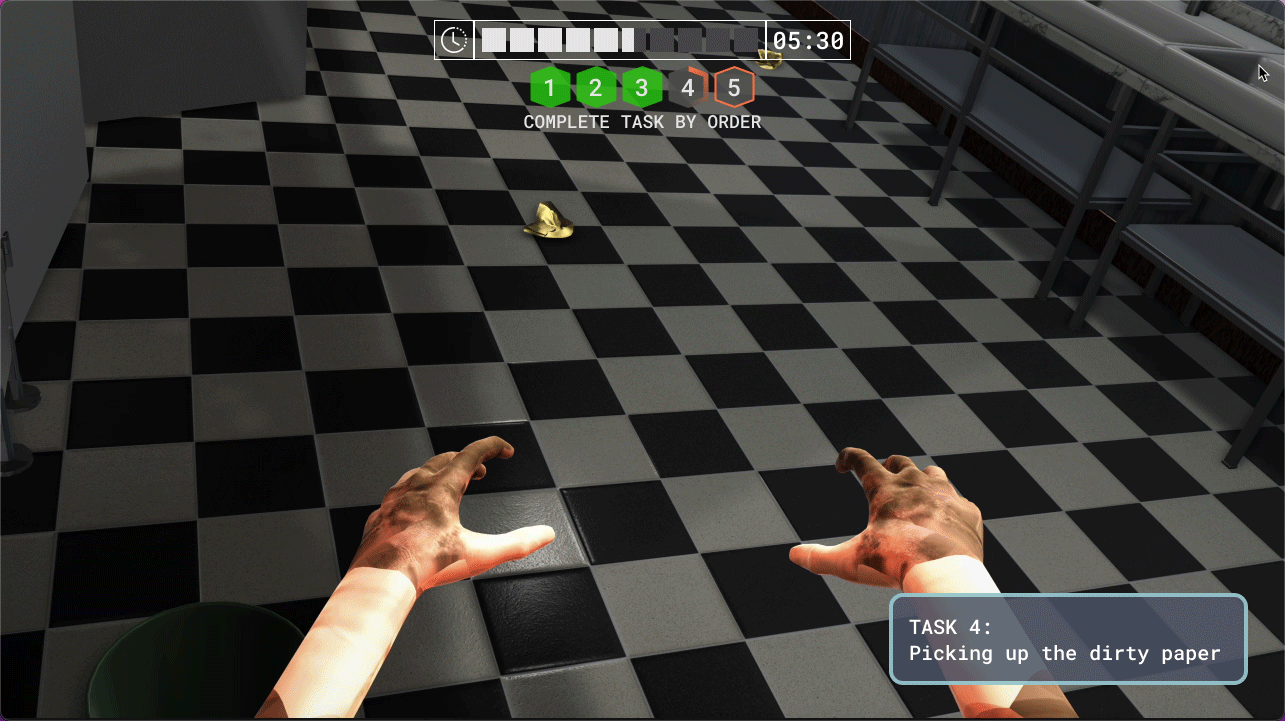
Providing hints
If the player hesitated to complete the task for over 2 minutes, the hints pop up for 5 - 8 seconds to clam down the player and provide direction for him. When there are only 3 minutes left, the timer would turn red as a way to alert and put a certain amount of pressure on the player.


USABILITY TESTING + FUTURE DEVELOPMENT
Usability Testing
I invited 4 mysophobia patients to participate in the game usability testing.






User 1






User 2






User 3






User 4
1. All of the users think the UI design of the game and instruction was clear and understandable, effectively showing the progress of the game and the task they need to complete.
2. All users were impressed by the concept of using a game as therapy. They found that the tasks targeted their specific issues. By completing them, they were able to alleviate their phobia.
3. 3/4 of users revealed that the hint feature effectively help them to complete the task when they were stuck without too excessive stress.
4. 2/4 of users reflected that they were less stressed about using the public restroom after completing the game.
5. 2/4 of users indicated that the lo-fi peaceful background music helped them to relax, which enabled them to be more focused while doing the tasks.
Overall, the majority of users believe that the Mysophobia Game has therapeutic benefits and wish to use it to treat their mysophobia.
Suggestions
1. Users suggested that the animation of the interaction could be improved for a smoother experience, which would aid in their engagement with the treatment and lead to better results.
2. They also mentioned that some objects were difficult to select.
3. A user suggested that adding more tactile feedback to the handle could provide a more realistic feel to users.
In light of these suggestions, I plan to improve my programming abilities and use Unity software more effectively to create an even more engaging experience for users, resulting in an even more effective treatment.
New Scenes
All users wish to experience more scenes, thus I constructed the subway scene as level 5 for the future development.

A distant view in the subway
In the subway scene, I designed 5 tasks for players:

Enter the subway station

Enter the subway

Take the escalator (touch handrail)

Sit down on the chair

Holding the handrail
REFLECTION
Leveraging technology to solve problems
I realized how long-existing/traditional problems could be solved so differently with evolving technology. Technology is a convenience tool that helps humans to solve problems possibly and properly. I am motivated to explore further the intersection of technology and human.
Developing more skills!
In 400 hours of learning and coding, I deepened my understanding of 3D engineering. I am able to enhance my Unity skills in various aspects, whether by structuring the scene using materials from assets stores or embedding code to form smooth interactions between the interface and players. I had more experience in using unity to create the games; also, sharpening my coding skill while making the project. I also got the opportunity to dig into the game’s UIUX design, which opened up a new type of design for me.